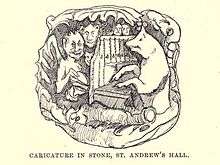Richard Noverre Bacon
Richard Noverre Bacon (1798 – 1884)[1] was an English newspaper editor, known as a writer on agriculture.
Life

He was the son of Richard Mackenzie Bacon of Norwich, and brother of Louisa Mary Bacon.[2] His journalism, over his years editing the Norwich Mercury which he took over from his father, promoted the current views on political economy.[3] He was cool on the role of the monarchy.[4]

Works
Bacon was an admirer of Thomas William Coke, and one of his aspiring biographers, as reported by Francis Blaikie. His work in that direction was in vain, however: Thomas Keppel, Coke's brother-in-law, took over as official biographer, gathering in the existing materials, and his biography was then lost in manuscript.[6]
Bacon wrote his major work as a prize essay for the Royal Agricultural Society[7] in 1843: it is considered the most detailed account of agriculture in Norfolk in the 19th century. He sent out over 80 questionnaires to prominent farmers in the county, the replies to which are still on record.[8] The second edition appeared as The History of the Agriculture of Norfolk (1849).[9] The work is a successor to the 18th century agricultural authors who wrote on Norfolk agriculture: Nathaniel Kent, William Marshall and Arthur Young.[10]
Notes
- Charles George Harper, The Newmarket, Bury, Thetford, and Cromer Road: sport and history on an East Anglian turnpike (1904), p. 307; archive.org.
- Warrack, John. "Bacon, Richard Mackenzie". Oxford Dictionary of National Biography (online ed.). Oxford University Press. doi:10.1093/ref:odnb/1006. (Subscription or UK public library membership required.)
- F. David Roberts (7 August 2002). The Social Conscience of the Early Victorians. Stanford University Press. p. 88. ISBN 978-0-8047-4532-1. Retrieved 21 April 2012.
- Anna Clark (2004). Scandal: The Sexual Politics of the British Constitution. Princeton University Press. p. 190. ISBN 978-0-691-11501-6. Retrieved 21 April 2012.
- . Dictionary of National Biography. London: Smith, Elder & Co. 1885–1900.
- Anna Maria Diana Wilhelmina Pickering Stirling, Coke of Norfolk and His Friends; the life of Thomas William Coke, first earl of Leicester of Holkham vol. 1 (1908), p. viii; archive.org.
- Richard Noverre Bacon (1844). The report on the agriculture of Norfolk to which the prize was awarded by the Royal agricultural society of England. Ridgways. Retrieved 21 April 2012.
- Susanna Wade Martins (18 September 1980). A Great Estate At Work: The Holkham Estate and Its Inhabitants in the Nineteenth Century. Cambridge University Press. p. 110. ISBN 978-0-521-22696-7. Retrieved 21 April 2012.
- Richard Noverre Bacon (1849). The History of the Agriculture of Norfolk. Ridgway. Retrieved 21 April 2012.
- Naomi Riches (10 March 1967). The Agricultural Revolution in Norfolk. Psychology Press. p. 7. ISBN 978-0-7146-1356-7. Retrieved 21 April 2012.